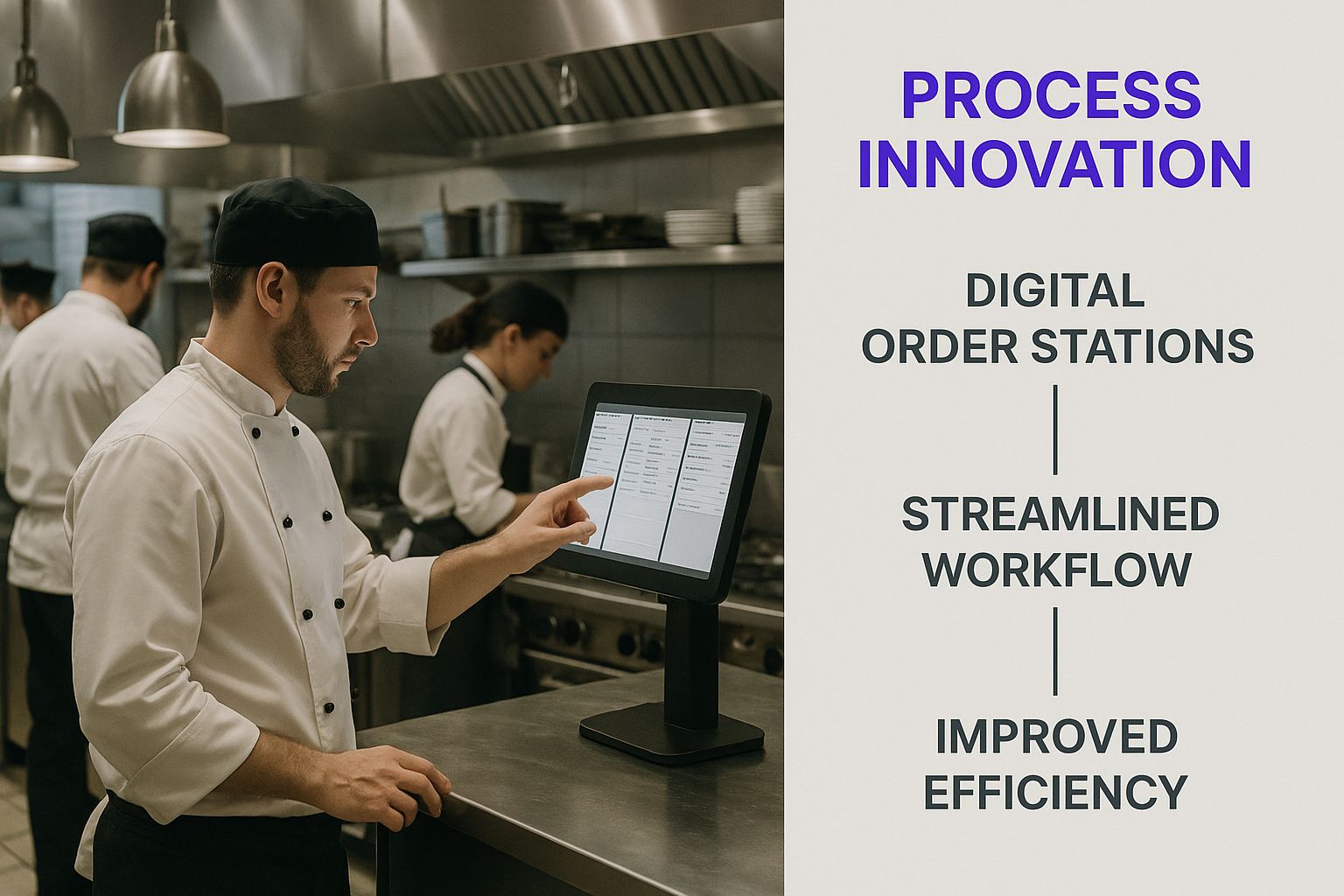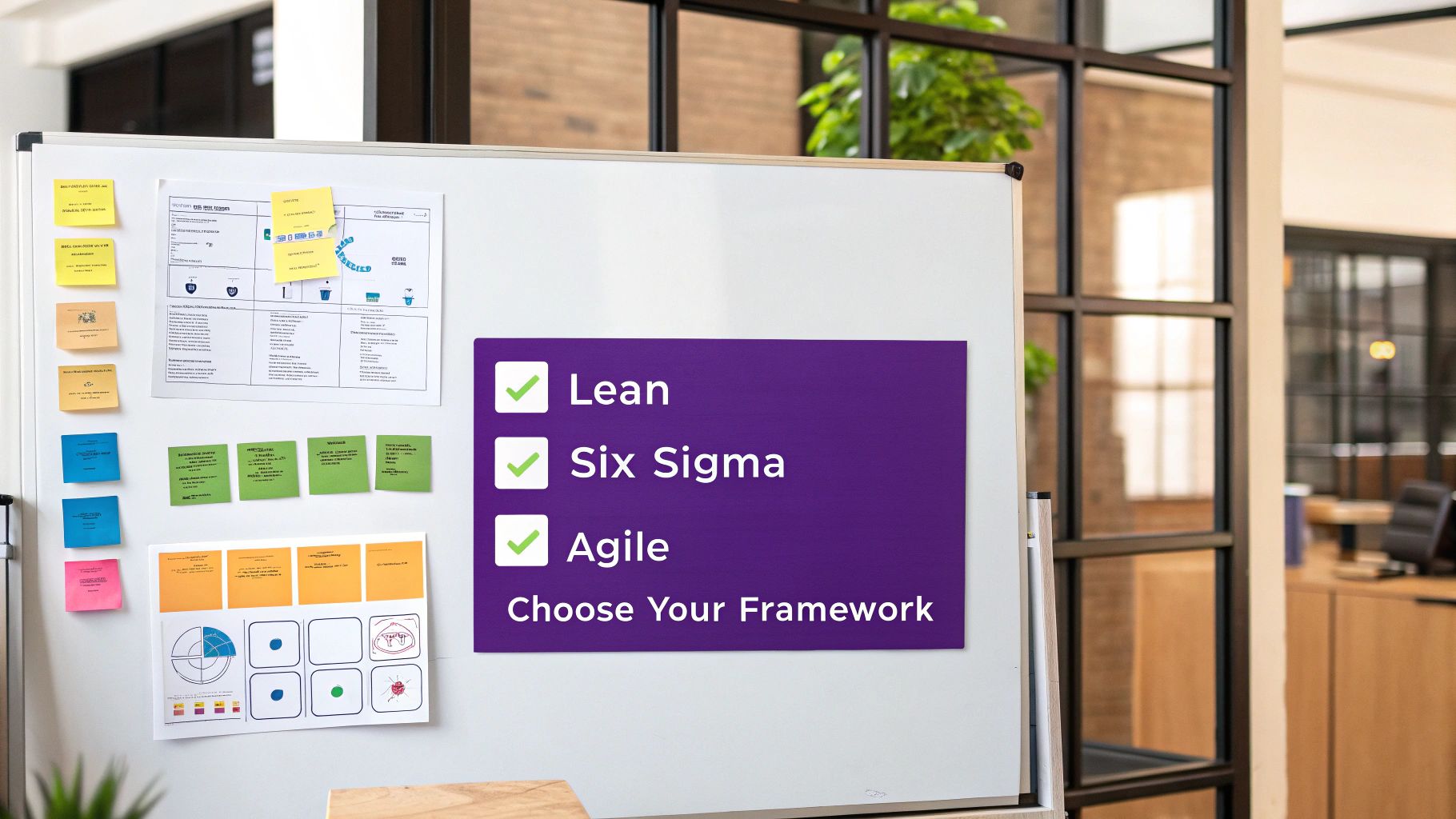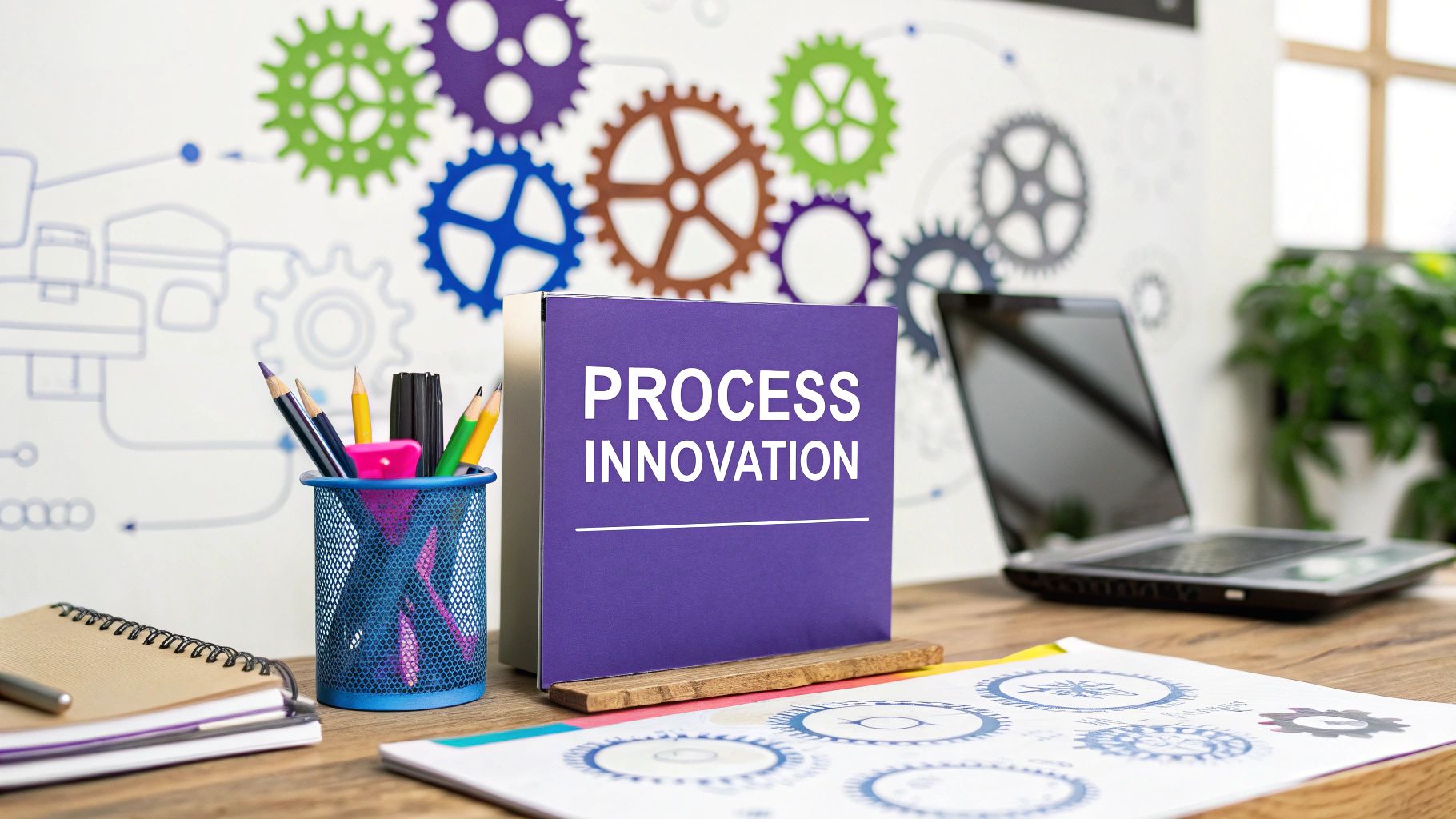When we talk about innovation, our minds often jump to flashy new products or groundbreaking inventions. But some of the most powerful changes happen behind the scenes. Process innovation is all about fundamentally rethinking how work gets done to get better results.
Think of a bustling restaurant kitchen. The old way might be a chaotic system of handwritten orders shouted across the room. Process innovation is like swapping that chaos for a streamlined digital system. The outcome? Faster service, less waste, and happier customers. It's not a new menu, but it completely changes the game.
What Is Innovation in Processes Really About?
At its heart, process innovation isn't a one-and-done project. It’s a commitment to constantly finding smarter, more efficient ways to operate. It’s about turning your everyday workflows into a secret weapon that gives you a competitive edge.
This approach goes beyond just fixing what’s obviously broken. Instead, you're proactively looking for ways to improve how your team collaborates, creates, and delivers value. For remote teams, this is non-negotiable—clear, efficient processes are the glue that holds everything together. The real goal is to get rid of friction, automate the boring stuff, and free up your people to focus on work that truly matters.
The Mindset of Continuous Improvement
Embracing process innovation means building a culture where it’s normal to question the status quo. It’s about encouraging your team to ask a few key questions about how they work:
- "Why do we do it this way?" So often, we follow old processes just because "that's how it's always been." Questioning them can reveal steps that are completely unnecessary now.
- "Can we make this simpler?" Complex workflows are often just a series of simple tasks tangled together. Unraveling them makes everything more manageable.
- "Could technology help here?" Finding the right spots for automation can save an incredible amount of time and cut down on human error.
- "How does this process affect the team?" A great process should make work feel easier and more satisfying, not add another layer of complexity.
This infographic of a modern kitchen is a perfect visual. It shows how the right digital tools can transform a traditional, manual process into a super-efficient system.

The image drives home the point that true process innovation isn't just about bolting on new tech. It’s about weaving it into the core of your workflow to create a smooth, organized operation. Before you start innovating, though, it helps to get a clear picture of how things are actually working right now. Techniques like What Is Process Mining are fantastic for this.
Global Impact and Local Application
This drive for operational excellence isn't just a Silicon Valley trend; it's a global movement. From startups to multinational corporations, businesses everywhere are realizing that smarter processes are a key ingredient for growth. We're seeing emerging economies leapfrog older methods by adopting these practices to become more competitive on the world stage.
Ultimately, getting a handle on the different definitions of innovation in business is the first step. Once you understand the possibilities, you can start building a culture that’s always looking for a better way to work.
Choosing the Right Framework for Process Innovation

So, you’re ready to shake up your workflows. That's a great start, but good intentions alone won't get you there. You need a solid game plan. This is where frameworks come in—they provide the roadmap to turn your ideas for improvement into real, measurable results.
Think of these frameworks less as rigid rulebooks and more as proven recipes for success in process innovation. Each one gives you a different way to look at your challenges, so picking the right one depends entirely on the problem you're trying to fix. Let's dig into three of the most popular and effective approaches.
Lean: The Path of Simplification
The philosophy behind Lean is refreshingly simple: eliminate waste. It’s a lot like cleaning out your garage—you look at every single item and ask, "Do I really need this? Does this add any value?" If the answer is no, it's out.
In a business, "waste" can be anything that doesn't directly contribute to the final product or service. This could mean pointless meetings, redundant approval steps, or time spent just waiting around. Lean is fantastic for processes that have become clunky and slow over the years, helping you create a workflow that’s direct, purposeful, and delivers maximum impact with minimum fuss.
Key Takeaway: The Lean methodology is all about stripping away the fluff. It forces you to focus on the activities that truly matter to your customers and your business.
Six Sigma: The Pursuit of Perfection
If Lean is about decluttering, think of Six Sigma as being a detective. This framework is all about the data. It’s a hyper-focused method for hunting down and eliminating defects in a process until it's practically flawless.
The name itself points to a statistical target of achieving less than 3.4 defects per million opportunities. Imagine an assembly line for a new gadget. Six Sigma would be the tool you use to meticulously find and fix the root causes of every tiny scratch or software bug. It’s a disciplined, data-first approach that’s perfect for critical processes where quality and consistency are absolutely essential.
Agile: The Engine of Adaptation
Agile is like a chef who constantly tastes and adjusts a sauce as it simmers. Instead of mapping out a massive, rigid plan from the start, Agile teams work in short, focused bursts called "sprints." After each sprint, the team delivers a small, working piece of the project, gets real-world feedback, and uses that input to adjust the plan for the next cycle.
This iterative style is perfect for complex projects where you know things are going to change along the way. It values flexibility and customer input over sticking to a pre-written script. While it got its start in software development, its core ideas can be a huge help in any work that benefits from quick feedback loops and continuous improvement. Digging into the steps of the design thinking process can also give you more tools for this kind of iterative, user-focused work.
Comparing Process Innovation Frameworks
Choosing between Lean, Six Sigma, and Agile can feel tricky. Each has its own strengths, so it's all about matching the framework to your specific goal. This table breaks down the key differences to help you decide which approach makes the most sense for your team's next project.
| Framework | Primary Goal | Best For | Core Principle |
|---|---|---|---|
| Lean | Eliminate Waste | Improving efficiency and speed in existing processes. | Maximize value by removing non-essential steps. |
| Six Sigma | Reduce Defects | Enhancing quality and consistency in critical operations. | Use data to identify and eliminate root causes of errors. |
| Agile | Increase Adaptability | Managing complex projects with evolving requirements. | Deliver value iteratively and respond quickly to feedback. |
Ultimately, the best framework is the one that aligns with your company culture and the specific outcome you're aiming for. You might even find that a hybrid approach, borrowing elements from each, works best for you.
How Automation and AI Are Redefining Processes

Technology has always been a major driver for innovation in processes, but today, nothing is shaking things up quite like automation and Artificial Intelligence (AI). These aren't just tools for mindlessly ticking off repetitive tasks. Instead, they enhance our ability to work smarter, freeing up our brainpower for bigger-picture thinking and creative work.
A great way to think about it is like a pilot with a sophisticated autopilot system. The tech handles the routine flying with perfect precision, which lets the pilot focus on navigating unexpected weather, communicating with air traffic control, and making the tough calls. Automation and AI do the same for our work—they handle the predictable stuff, so our teams can tackle the truly complex challenges.
This isn't just a passing trend; it's a deep shift in how businesses get things done. The market for business process automation is expected to jump from USD 13 billion in 2024 to nearly USD 23.9 billion by 2029. Companies are pouring money into these tools because they see real results, with 56% already using AI to improve their day-to-day operations. You can dig into more business process automation statistics to see the full picture.
Unlocking Efficiency with Intelligent Tools
The real magic of AI in process innovation is its knack for spotting patterns in massive datasets—things a human would likely miss. It can turn a mountain of raw information into clear, actionable insights, helping teams zero in on what’s not working with incredible accuracy.
Here are a few real-world examples of this in action:
- Customer Support Analysis: Instead of a manager manually reading support tickets, AI can scan thousands of them in seconds to find recurring complaints. This helps teams find and fix the root cause of customer frustration.
- Automated Project Reporting: Forget about spending hours every Monday morning pulling numbers for a status report. Automation tools can grab data from all your platforms and build a live dashboard, giving your team more time to actually do creative work.
- Predictive Maintenance: In a factory setting, AI algorithms can predict when a piece of machinery is about to break down. This allows for maintenance to be scheduled before it fails, preventing expensive downtime and keeping production on track.
From Repetitive Tasks to Creative Solutions
When you automate the routine, administrative grunt work, you give your team back their most valuable resource: time. That reclaimed time is pure gold. It can be poured back into the activities that actually move the needle—strategic planning, talking to customers, and brainstorming new ideas. That’s where genuine innovation sparks to life.
By handling the mundane, technology creates space for the meaningful. It shifts the focus from "how do we get this done?" to "how can we do this better?"
To see how new tech is reshaping workflows, it's worth exploring how Artificial Intelligence in knowledge management is boosting efficiency. Far from making people obsolete, these smart systems often open up new doors for growth. We even have a guide on how AI can help us be more creative. The ultimate goal is a true partnership between people and technology, where each side gets to play to its strengths.
It's one thing to talk about frameworks and theories, but it's another to see process innovation come to life. The real "aha!" moment happens when you see how actual companies solved real-world problems by thinking differently about how they work.
Let's look at a few examples. I've broken them down into a simple "Problem-Innovation-Result" format to show you exactly what challenge they faced, the clever process they created, and the impact it had.
The E-commerce Store That Beat Stockouts
Problem: A growing online store was constantly running out of its most popular products. Their manual inventory tracking just couldn't keep up. The result? Unhappy customers, lost sales, and too much cash tied up in slow-moving items.
Innovation: They switched to an automated inventory management system. This wasn't just about counting stock; the new process used sales data to predict future demand. It automatically placed reorders when items hit a specific threshold and gave everyone a live look at what was in the warehouse.
Result: It was a game-changer. Within six months, stockouts dropped by over 70%, and they slashed their carrying costs by 35%. Customers were happier, and the team was finally free from endless spreadsheets, allowing them to focus on growing the business.
The Creative Agency That Sped Up Project Kickoffs
Problem: A creative agency was struggling with a messy client onboarding process. It was a chaotic mix of back-and-forth emails, scattered files, and manual data entry that often pushed project start dates back by a week or more. It was a frustrating first impression for new clients.
Innovation: The team built a slick, automated onboarding workflow. They introduced a client portal where new customers could upload all their files and information in one go. The system then used automated checklists and reminders to keep everything on track without anyone having to chase people down.
Key Insight: Don't underestimate the power of a smooth onboarding process. It sets the tone for the entire client relationship and gets your team to the creative work faster.
Result: The new workflow cut the average onboarding time from eight days down to just two. The agency could kick off projects sooner, which meant they could take on more work and impress clients from day one. You can dive into more detailed examples of innovation processes in our dedicated guide.
These kinds of improvements have a massive economic ripple effect. Just look at the industrial process sector—it includes over 360,900 companies around the world. In 2023, manufacturers alone accounted for about USD 2.38 trillion in economic activity, showing just how much value is created when processes are sharp and efficient. You can learn more about the industrial process market outlook and its continued growth.
Driving Process Innovation in Remote Teams
Let's be honest: making big changes to how your team works can feel tough when you're all in different places. You can't just grab a marker and head to the nearest whiteboard. Those little impromptu chats by the coffee machine that often lead to "what if we tried this?" moments are gone.
But here’s the thing—this distributed setup is exactly where smart innovation in processes can have the biggest payoff.
For remote teams, solid processes are more than just a nice-to-have; they’re the foundation for everything. Without clear workflows, tasks get dropped, communication gets tangled, and that feeling of distance between colleagues only gets bigger. The trick is to see this challenge as a chance to use your digital tools for more than just talk. They can become your dedicated space for constant improvement.
Building a Virtual Workshop for Process Mapping
One of the best ways to get the ball rolling on process innovation is to run a remote process-mapping workshop. This isn't about another long, draining video call. It's about creating a hands-on, collaborative session where every single person feels they can chip in, no matter where they are.
Here’s a simple way to pull it off:
-
Set the Stage Asynchronously: Before you even think about a live meeting, send out a quick document or video explaining the goal. Ask everyone to map out the current steps of a process on their own time using a shared digital whiteboard like Miro. This prep work is gold because you get everyone’s unfiltered perspective.
-
Facilitate a Focused Live Session: The live call is for discussion, not starting from scratch. With the whiteboard already full of everyone's input, you can jump straight into spotting the differences. This is where the real magic happens—you’ll uncover hidden bottlenecks and steps that don't make sense anymore.
-
Ideate on Solutions: Once you've pinpointed the problem areas, break everyone into smaller virtual rooms to brainstorm improvements. This gives quieter team members a better chance to share their thoughts and helps you get a wider variety of ideas.
-
Define Actionable Next Steps: Don't let the momentum fade. End the workshop by giving clear ownership for testing out the new ideas. Use a project management tool like Asana to keep track of progress so those great ideas actually become reality.
If you’re looking for more ways to build the right atmosphere, our guide on fostering innovation in remote teams has plenty of other strategies for creating a strong, collaborative culture from afar.
Finding the Right Tools for Innovation
The right technology makes all the difference for remote process improvement. Tools like Bulby are built specifically to walk teams through structured brainstorming, helping you get past the creative roadblocks that can pop up when you're not in the same room.
This screenshot shows how a tool can offer guided exercises, turning a standard meeting into a session that actually produces results.
By offering a clear path forward, these platforms help keep brainstorming on track and ensure everyone’s voice is part of the solution.
Key Insight: In a remote setup, your digital toolkit sets the ceiling for what you can achieve together. Pick tools that actively guide structured thinking and problem-solving, not just ones that let you talk.
At the end of the day, driving innovation in processes on a remote team comes down to being deliberate. It means creating specific, intentional moments for collaboration and using technology to close the physical gap. When you do that, continuous improvement becomes a natural part of your team's culture, no matter where they're logging in from.
Common Questions About Innovation in Processes
Alright, so you've got the frameworks and you're eyeing some tools. But even with the best intentions, actually starting with process innovation can bring up a lot of questions. It's totally normal to wonder where on earth to begin or how you'll know if any of your changes are actually making a difference. Let's tackle some of the most common hurdles you'll face.
Think of this section as your practical field guide. We're moving past the theory and into the real world to address the concerns that pop up the minute you start trying to change the way your team works.
Where Should a Small Team Start with Process Innovation?
If you're a smaller team, the golden rule is this: start with something that’s both frustrating and frequent. Don't try to boil the ocean by overhauling your entire operation at once. Pick a single process that causes daily headaches—maybe it's your client onboarding, the back-and-forth of content approvals, or how you pull together weekly reports.
The perfect starting point is a task where even a tiny improvement would make everyone breathe a sigh of relief. Huddle up with your team, map out the current steps, and find the one thing that slows everyone down. Your first goal isn’t to reinvent the wheel, just to make one small, measurable tweak. This could be as simple as a shared digital checklist or a basic automation. Nailing these quick wins builds the confidence and momentum you need to tackle bigger challenges down the road.
How Can You Measure the Success of Process Innovation?
You can’t improve what you don’t measure. It’s an old saying because it’s true. The success of any new process has to be tracked against clear goals you set beforehand. A vague feeling that things are "better" isn't enough; you need hard data to show your changes are really working.
Focus on tracking a few key areas:
- Efficiency Gains: How much time are you saving per task? How many steps did you cut out of a workflow? Are projects getting done faster?
- Quality Improvements: Are you seeing fewer errors? Are customer complaints down? Are satisfaction scores up?
- Cost Savings: This can be direct, like a drop in operational expenses, or indirect, like wasting less time or fewer materials.
For instance, if you shake up your hiring process, you could measure success by tracking the average time it takes to hire someone and the retention rate of those new employees. Just remember to always measure how things are before you make a change. That baseline is what proves your "after" is a genuine improvement.
Will Implementing New Processes Stifle Team Creativity?
This is a big one. A lot of people worry that putting new processes in place will kill creativity. But when done right, the opposite is true. A well-designed process doesn't restrict creativity; it liberates it. Think of it like building the foundation and frame of a house. Once that solid structure is in place, you’re free to get creative with everything inside.
By taking away administrative busywork, repetitive tasks, and general confusion about what to do next, you give your team their brainpower back. They can finally focus on the strategic, creative work that actually moves the needle. A good process is a launchpad for creativity, not a cage.
The secret is to involve your team directly in designing the new workflow. When people help build the framework they'll be using, they make sure it supports what they need and gets rid of the boring stuff they hate. Suddenly, it’s not a top-down rule; it’s a shared tool for working smarter.
Ready to build smarter processes for your remote team? Bulby provides the guided, structured brainstorming exercises you need to turn frustrating workflows into sources of efficiency and creativity. Start innovating with Bulby today.

